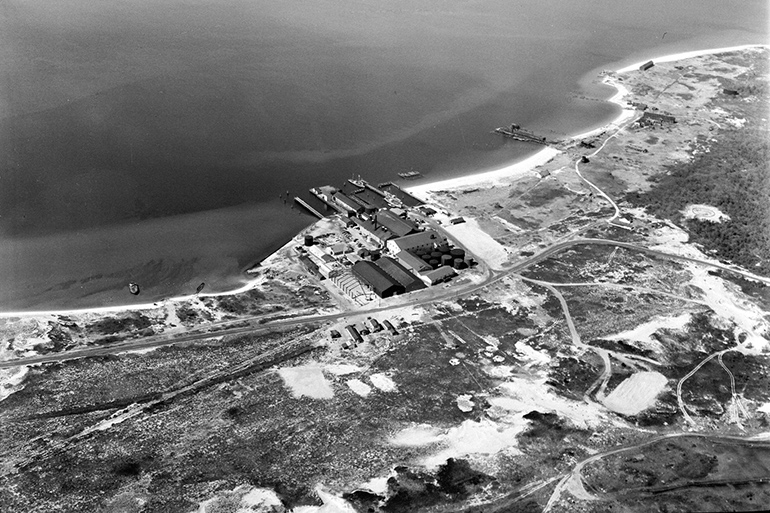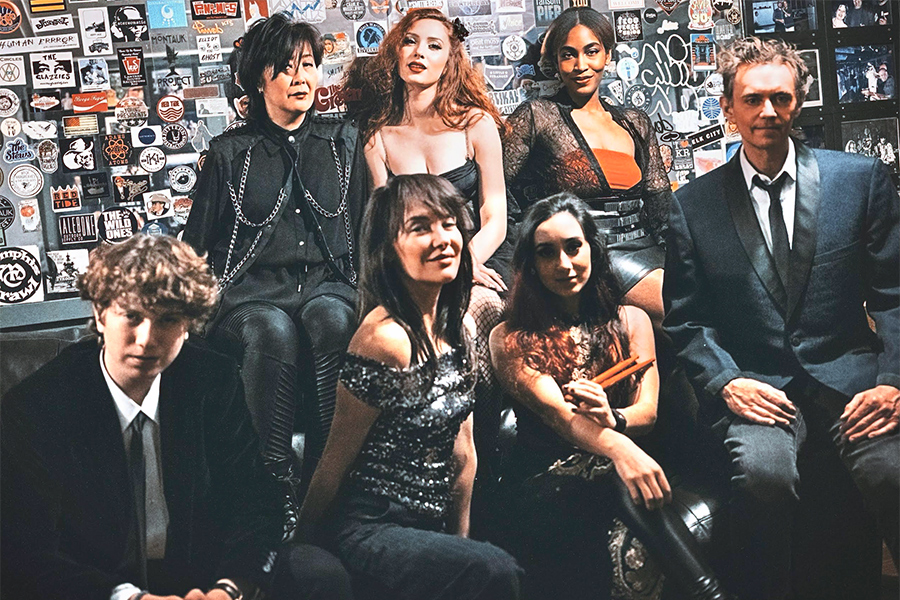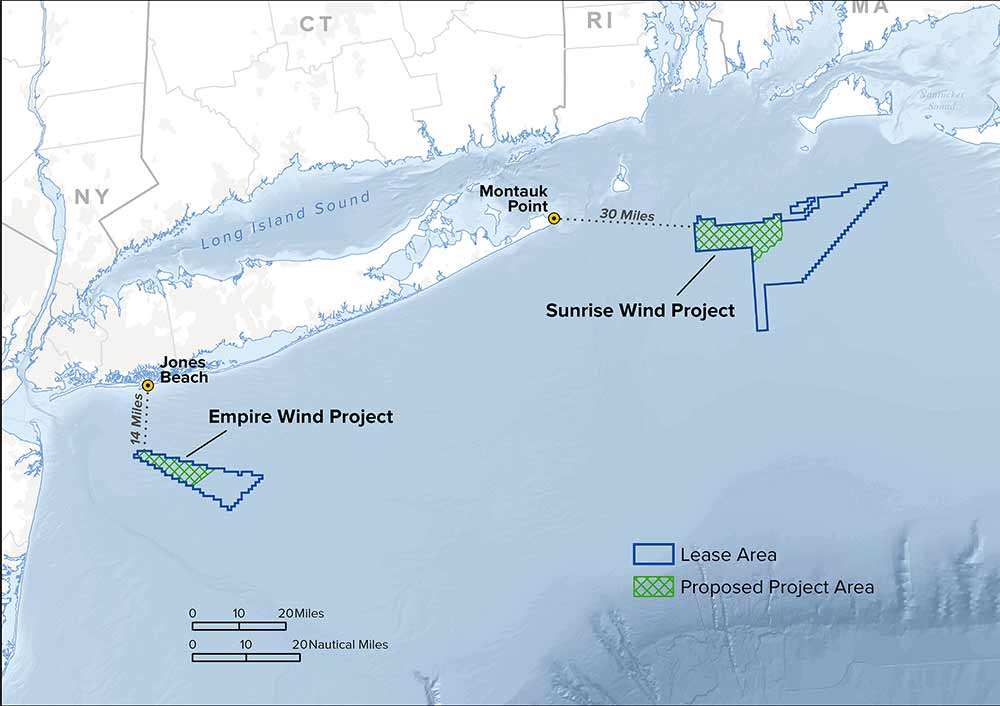The Napeague Legend: Stinking Fish Factories vs. Two Millionaires Who Built Mansions There

Driving east from Amagansett, the Montauk Highway dives down a hill onto the six-mile-long arrow-straight Napeague Stretch. In 1955, at the age of 16, sitting in the back seat of my dad’s Oldsmobile, I experienced that drop for the first time. It was not like it is today.
At that time, there were only low scrub bushes in the sand dunes on either side of the highway. You could see the ocean on your right and the bay on your left. Montauk was on the horizon ahead. And for the first hundred yards on the shoulder of the road facing you were an array of about 20 huge billboards hoping to entice you to board a fishing boat, stay in a particular motel, eat at a certain restaurant and buy land—oceanview lots of a quarter-acre in Hither Hills with beach rights were selling for about $5,000 each, just call the phone number on that sign.
A great drop in temperature hit you when you came to the bottom of that hill. And often, if you came before noon, there was fog. On other occasions, when the wind was from a certain direction, you could smell the awful stink of dead fish coming from somewhere.
My father, driving through this awful smell, explained it to my mom, me and my sister. It was caused by fish being boiled in giant cauldrons. There were five fish factories, he told us, about a mile apart from one another on the arc of the bay. Commercial fishing boats tied up at the docks of these factories to unload their hold full of thousands of menhaden, a small baitfish.
The fish were hauled off the boat and dumped into large iron cauldrons of boiling water. A coal fire underneath kept them boiling 24 hours a day, because you never knew when the fishermen would come in. Portuguese immigrants and African-Americans manned the factories. The fish were boiled down into paste. The paste was put into barrels, and the barrels were put into railroad freight cars that hauled them off to factories in Queens to process them into glue, fertilizer, oil or paint.
“The five factories were built in the 1890s, when the railroad laid the track through to Montauk,” dad told us. “There’s offices, a warehouse, coal bins, barracks buildings for the help, but no electricity, plumbing or hot water. The factories are in business from June to September.”
We were coughing and gagging. Couldn’t they get rid of the smell?

“People living around here tried. From what I’ve been told, they filed lawsuits. It went all the way up to the Supreme Court. In the end, Congress passed a law guaranteeing the factory owners’ claim to the land. So now it’s called Promised Land. Anyway, in a few minutes, we will be beyond the smell. And you only smell it when the wind is in the wrong direction.”
Thus was I, at the age of 16, introduced to the gateway to Montauk. It was the first time my sister and I had been to Montauk. We had been driving for four hours, from Millburn, New Jersey, a suburb not too unlike Great Neck, where we had lived since we were born. Dad had come out numerous times in the prior year. He was a pharmacist and he was buying White’s Drug Store in Montauk, staying at the Bosco Rooming House on weekends. He loved fishing. Mom was going along with this. We were now coming to the east end of Long Island for good.
The fish factories today are long gone. They went out of business in the 1960s, when the menhaden fishing declined and the factories no longer turned a profit. There is a stout brick chimney on the beach still standing from one of the fish factories, though. And there is another fish factory, an abandoned rusty metal shed the size of half a football field, still standing, that in recent years was restored to become the Amagansett Multi Aquaculture Systems.
Fish are hatched and raised here. And, oddly, the owners serve delicious dinners there today, chicken and fries and other things outdoors on picnic tables overlooking the sunset. Call them for a reservation.

And there is another fascinating story, a legend, about the fish factories.
In the first decade of the 20th century, two millionaires from Cincinnati came out to the wilds of Montauk to go fishing and hunting for a week with their friend Arthur Benson of Brooklyn. Benson owned the wilds of Montauk—almost completely uninhabited—and often invited friends out.
The millionaires were William Cooper Procter (of Procter & Gamble), and Richard Levering (of Lever Brothers), owners of household cleaning products that competed with one another, and they so enjoyed their time with Benson in his makeshift cabins that they asked if they could buy some land and build two houses out there. Benson said he wanted to keep his property pristine, but they could surely buy property atop the hill in Amagansett, overlooking Napeague and just a short horseback ride to Montauk. They’d have full access, any time.
When the millionaires returned to Cincinnati, they called long distance to an East Hampton real estate agent and told them they would like to build two identical mansions atop that hill. The agent thought about telling them of the smell, but in the end decided not to do so. He had two rich fellas here.
They told him they wanted their mansions electrified, that they wanted the finest furniture and linens, and they wanted these two mansions completed within a year so they could come out with their families to hunt and fish in the luxury to which they had become accustomed. Don’t bore us with details, they told him. And money is no object.
The two homes were constructed—the workmen wore masks—and ready the following spring.
For electricity, a power plant was built just out of the view of the most westerly of the fish factories. A contingent of Portuguese immigrants built it. A 100-foot-long dock extended out into the bay from the plant, and running along this dock was a small narrow gauge railroad track that started here and went up the hill to the mansions. (Parts of the trackage are still there.) The families could arrive in their yacht, step off the ship and onto this small handsome two-car train that would take them up the hill to their new home. What could go wrong?
The wind was blowing from the south when the steamer arrived on July 1, 1911. There was no smell. The families cheered as their white mansions, three stories high, came into view atop the hill. Porters loaded their luggage and escorted them to their seats on the steam train.
Arriving at the top, the families found the place fully furnished down to the curtains, linen and silverware. The servants greeted them. They ate dinner, then went to bed. About an hour before dawn, the wind changed.

And so they awoke, coughing and gasping, then raced for the little train to take them out of this. Within the hour, they had steamed off over the horizon. They never came back.
Two things about this story. When I first was told it, I doubted it was true. But in 1955, the two mansions were still there, now abandoned. There were also abandoned carriage houses and servants buildings.
As it happened, I got the name of the man who was in charge of the mansions and the power station. I do not remember his name, but before publishing a story about the Promised Land in Dan’s Papers back then, I did phone him at his home in Bay Shore, where he was living in retirement now 50 years along.
He spoke English with a thick Italian accent. He told me he had come to America aboard a “Liberty” ship during World War I—these were the ships that brought American soldiers to Europe to fight in that war and were now coming back empty—and I recall asking him details about the story. One detail was to tell me the name of the little railroad’s steam engine.
“Airculous,” he said. I wrote it down.
Before publication, I ran the story by a friend of mine named Ron Ziel, who was a railroad buff. He looked at the name “Airculous” and blinked.
It’s “Hercules,” he told me.



